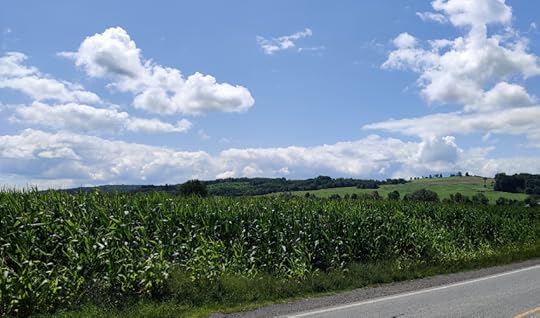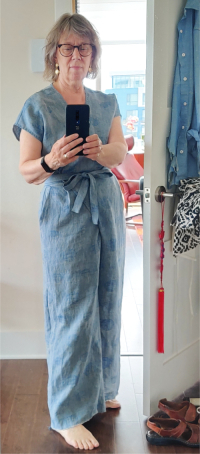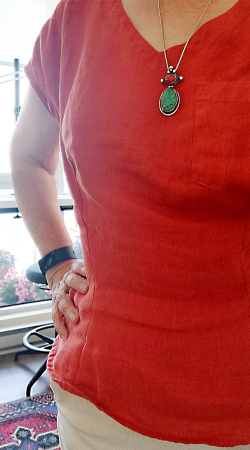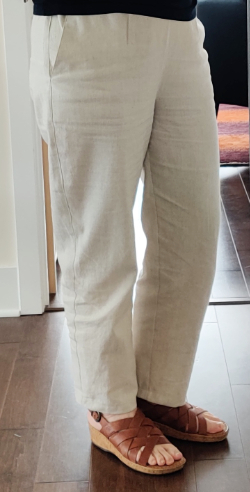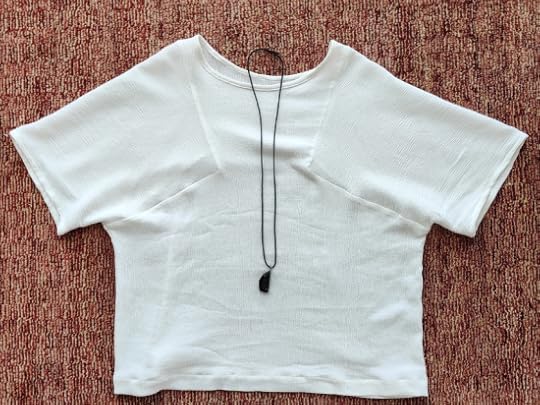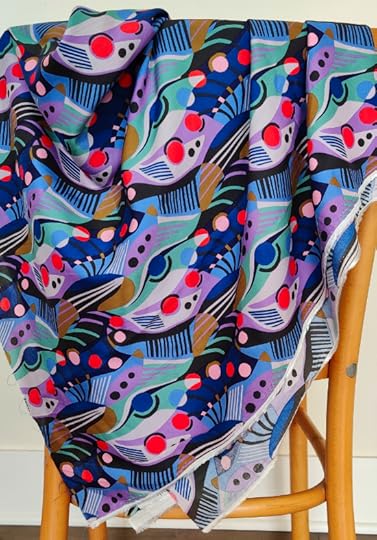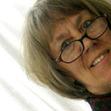Elizabeth Adams's Blog, page 8
December 15, 2023
Short Story with Swans
Mountains and Orchard
The large mountains behind the city of Edessa intrigued us, and one afternoon, curious about what we might find, we drove west of the city and up into them. After leaving the main highway, we followed a smaller paved road through huge orchards of densely-planted, unfamiliar fruit trees with an upright habit of loosely vertical branches -- were they almonds? I got out to take a closer look, and decided they might be cherry trees, but there were more than we imagined possible, stretching for miles in every direction, the only cultivated crop in what appeared to be a rocky, dry wilderness.
After traveling along these orchards for a while, we came upon a small hill village. It was built of rock, and although we saw a few cars and motorcycles parked along the roads or in driveways, there were no people walking around, just a few stray cats and the occasional dog. The little closely-placed houses seemed well cared for, with tall, blooming rose bushes and sometimes a heavily laden pomegranate tree in a front yard. But the village streets were so steep that our underpowered car needed several tries to gain the top of one of them.
After leaving the village, all signs of habitation gradually vanished. The road, now unpaved, climbed and narrowed; the slopes became steeper and rockier, and the vegetation wilder. Figs and hop vines scrambled with abandon over every tree and rocky outcrop. Just as we were about to declare defeat and turn around before the road became impassable, we suddenly came upon a blue lake with a flock of large white birds on it, in the middle of nowhere.
We pulled the car off onto the non-existent shoulder of the road, and got out; the water wasn't far from the road itself and you could stand on the edge and get a good look at the birds, who seemed unconcerned about the presence of human eyes. All of the white, large birds were swans but, closer to us, we could also see a flock of small ducks that I couldn't identify. Wildflowers, some of which were familiar and others not, bloomed on the edge of the bank, and behind the lake, the mountains rose: dry, rocky, bare except for the occasional patterned rows of a vineyard or orchard. Just beyond them was the border, and North Macedonia.
After ten minutes or so, we heard a vehicle approaching. It was a small beat-up truck that stopped when it came around the bend in the road and saw our car, parked on the side. The driver peered at us out his window, and then pulled off in a nonchalant fashion which seemed to indicate both familiarity with the road, and that there was seldom any traffic to worry about. Both doors opened, and a middle-aged Greek couple got out and walked closer. Initially they seemed concerned that we'd had a breakdown, but they quickly realized, when we gently gestured toward the water, that we were watching something. I recalled "poulia" - "birds" - but couldn't remember the word for swan, which annoyed me because the word appears along with a picture of a swan on the red tins of the "swan" brand of Greek tomato paste and sauce. I had liked those tins so much that I had brought an empty one home, from our first trip here, to use in my studio.
But the couple now said "swans" aloud -- "keeknous!" - and nodded to us in some excitement. They walked over to the side of the road to get a closer look. "Mikres papies" said the woman, pointing at the little birds in the foreground, "little ducks." I nodded and repeated, "papies," which was another word I had learned and forgotten.
The four of us stood watching the birds on the blue water for a few minutes, and then they turned to us, quizzically. Both of them had open faces, and were dressed simply; they were probably local people who lived nearby. He was stocky, with a round face and short grey hair; she was short, smiling, and blond. "Tourist?" they asked. "Canada," I said, pointing at both of us. "We like your country," I managed to say in Greek, and in a combination of pantomime and words I conveyed that it was our third trip there. "How long?" they asked. "Three weeks." "Pou?" "Where?" "Edessa, Thessaloniki, Ioannina, Athens..." I stumbled over the word "Chalkidiki", the peninsulas to the east of Thessaloniki, and looked to them for help, and they quickly pronounced it for me. We all laughed.
Before they had arrived, I had plucked a ripe fig from the tree growing wild on the lake side of the road, and the woman spotted it in my hand. Ah! she said, and told her husband to go look. She brought her cupped hand to her mouth and raised her eyebrows, then pointing at my hand, wanting to know if I had eaten one. I shook my head no. The man went over to the tree and rummaged through the branches, looking for the best fruit, and picking a handful. He held out his open palm to me, and to my husband, proffering the small, dark figs. We each took one, and he pressed us to take more, so we did. The man nodded slightly, pointing his index finger toward me and then toward himself in a gesture that said, "Look!" He took a fig between his left forefinger and thumb, and began to slowly but deftly peel off the skin with his right hand, looking over at me to make sure I was watching -- it was a lesson. Then he split the flesh, examined it to make sure it met his expectations, and handed the peeled fig to me, gesturing to me to eat it. I took the fig and ate it in two bites; it was delicious. "Nostimo," I said. "Efcharisto!" ("Delicious, thank you!") and we all began to pick and lazily peel and eat figs, keeping the unconcerned, floating swans in the corner of our vision. The woman split a fig open, laughed, and shook her head "no", making a wiggling gesture with her finger as she showed it to me -- that one had a worm in it. I nodded, and glanced at Jonathan, who raised his eyebrows and surreptitiously dropped the fig he had been holding into the bushes.
Swan and wild fig tree
After a little while, we felt it was time to leave, and I gestured to the couple that we were going back to our car. They had been talking together and grazing on the figs, while J. and I took some pictures of the swans and the lake, but now we approached them to say goodbye. I smiled at the man and put my hand on my upper chest. "Elisabeth," I said. He grinned and said, in Greek, "Like the queen!" I got it and laughed and nodded, then pointed to Jonathan and said his name. They shook hands. The man touched his own chest and said, "Konstadinos," and then turned to his wife, who was also smiling at us, and said, in halting English, "She is -- Chryseis. It means...gold."
We drove back through the endless orchards of fruit trees, down the winding roads through the stone villages, until we re-joined the main road that led to the Edessa highway. I couldn't believe I had actually met someone named Chryseis. At the beginning of the Iliad, a young Trojan virgin of that name has been seized by the Greeks and given to their leader, Agamemnon, as his slave and mistress. She is the daughter of Chryses, a high priest of Apollo, but Agamemnon refuses her father's pleas to return her. Chryseis, desperate, prays to Apollo. The god hears her and sends a plague that strikes the Greek camp...and sets in motion further events that alter the course of the war. (The name Chryseis literally means "of Chryses", and it is Chryses that means "golden".)
When we were finally back at our inn, we asked the innkeeper about the fruit trees we had seen up in the mountains. She asked us what towns we had been near. "Agras?" I offered. "Nisi?" She nodded, and answered, "Then they must have been kerasies. Cherries." She gazed at us calmly with that knowing, slightly sly smile we've seen on many Greek faces when suggesting something we must do or try: the special dessert they are offering "on the house", the free glass of homemade tangerine liqueur, the sight to be seen if we would just walk up to the top of the hill. "You must come back in the spring," she said, "when they are all in bloom!"
November 16, 2023
A Brief Stay in Exarcheia
Today, November 17, marks the fateful day in 1973 -- fifty years ago -- when tanks were driven through the gates of the National Polytechnic University in Athens in an attempt to put down the student-led uprising against the military junta that had ruled Greece since 1967. 24 civilians were killed. Several days before, students had barricaded themselves in the main university buildings and called on their fellow citizens to rise up. These events are acknowledged today as the beginning of the overthrow of that oppressive regime. They are still commemorated with a permanent shrine, including the wrecked and twisted metal gate, inside the university entrance where many of the victims fell.
In preparation for today's expected 50th-year commemoration, we hear that 5,000 police have been stationed in strategic areas around the city, including at the US and Israeli embassies. The US embassy is the usual end point of student marches on this date every year, since the country is generally blamed by them for having been in league with the military junta, and now for being a partner in "imperialist wars." The police have said that drones and helicopters will be hovering and transmitting images to their operations center throughout the day. Yesterday, crowds of people, as well as the political opposition leader and the head of the communist party, laid wreaths and carnations at the Polytechnic site in memory of the students who were killed.
The surrounding neighborhood, called Exarcheia (or Exarchia) continues to be known as the home of anarchists, activist students, and bohemian intellectuals who oppose the government's authoritarian and conservative policies. In recent decades it also became a refuge for migrants who established squats in empty buildings, with periodic crackdowns by the government to clear out those settlements. The clashes between students and police have often included tear gas, Molotov cocktails, and broken windows. However, Exarcheia also one of the most vibrant and interesting neighborhoods in the city, and we've stayed there twice.
I drew this view into the courtyard of the historic neoclassical buildings of the Polytechnic University back in 2019, from our apartment balcony. At that time, students had taken over the main building and seemed to be living there, and in the evenings there were meetings with music and speeches in this courtyard -- all peaceful but continuing well into the late hours. These were the original university buildings; the main campus is now located elsewhere.
---
After arriving in Athens our taxi dropped us off at our small hotel, where we'd be for the next two nights, and after a nap we went out to explore. Many tourists would probably be freaked out by Exarcheia, with its Marxist posters, abundant graffiti, edgy vibe, and continual police presence. We were prepared for that because we'd stayed in the area previously and realized there was little to fear under normal circumstances. What got to us this time wasn't any perception of danger on the streets, but the greatly increased police presence since four years ago: large groups of helmeted police riding motorcycles through the narrow streets at all hours, and three huge buses filled with police in full riot gear, with shields, parked on a main street, apparently perpetually ready to confront a student demonstration. Maybe, as children of the 1960s and peace activists who have experienced plenty of this ourselves, it feels unfortunate and wrong, but not that abnormal.
The next morning, jet-lagged but hungry, we walked up to a block of small restaurants with outdoor seating that we'd passed the night before, coming home from dinner. We chose a little eastern-European café, and sat there for an hour and a half, watching what was going on as the street came alive, shops opened, and people began their days. The gentleman shown in the drawing passed us, wearing a long black coat and carrying an armload of heavy books. He sat down at a table outside the door of the neighboring café, where he was greeted by the server in a way that made me think he must be a habitué. Was he a retired professor? Were those clerical robes? He didn't seem to be an Orthodox priest. Whatever the case, I'm sure he was doing exactly what he did on many mornings in his own familiar neighborhood - sitting at that same table, ordering coffee, reading, checking his phone, and having a few cigarettes. Likewise, the man who ran the small fruit and vegetable shop on the other side rolled up his awning and came out to chat with a fellow who pulled up on a motorcycle, then later a woman doing her morning errands, and two men who sat down at a table to smoke with him: longtime neighbors and friends.
When our young server returned to the table with our breakfast order, I asked how things were going, and mentioned the police buses we'd seen the previous night. He shook his head and asked softly: "You know about this neighborhood?" We nodded. "It's been getting worse and worse. Constant intimidation, on the orders of the government. It's to try to keep the students quiet, keep them from protesting their policies. And the problem is, say if something bad happened or you had an accident late at night and needed help, then no one would come." We had the impression that student opposition to the government's immigration policies was at the heart of this increased intimidation, and also their direct opposition to police brutality, but there were many other issues as well, from economic policy to the planned construction of a new metro stop in the heart of the neighborhood.
Typical posters pasted up on the streets announced demonstrations, and exhorted people to take action on various issues, such as migrant rights, anti-police brutality, anti-capitalism, anti-fascism, war in the Ukraine. The large letters on the top poster here say something like (Greek speakers please correct me!): The Elector is Responsible / Remember / The people choose the leaders they deserve. It's accompanied by a picture of Karl Marx. (This is basically the same as Alexander Hamilton's famous quote: "People get the government they deserve" - an ironic comment from an American founding father, in the light of current world and domestic events.) The next sentence in black letters, is a quote from the "national poet of Greece", Dionysios Solomos (1798-1857), and reads: "My poor people, good and beloved. Always gullible and always betrayed." The poster below says "Marxism 2023" and advertises an action that took place this past July in Athens.
There's a lot of graffiti everywhere. It ranges from spray-painted names and tags, such as those above, to some breathtaking murals like the one below.
Everything in Exarcheia is not political. Because of the intellectual/artist/student vibe, the area is filled with small bookstores, art supply stores, vintage and ethnic clothing and thrift stores, small artist and craft boutiques, cafés and restaurants -- many of which are very good and far more affordable than those a few blocks away near the city center and Syntagma Square. One of our favorite restaurants is a mezedopolia, or "small plates" restaurant specializing in meze, located at the top of the hill. You eat at café tables in an outdoor terrace where vines climb on the rustic pergolas overhead, and cats wander between the table, in an atmosphere of convivial groups of friends. The food is fantastic, the wine and ouzo are great, and who could complain about jasmine blossoms falling on your table as you finish your coffee?
During our three visits to Greece, we've spent considerable time in Athens and grown to love this gritty, complicated city not just for its monuments, art, and cultural history but also for its people and vibrancy today. Most tourists sleep and spend their time and money in the city center and the area around the Acropolis. These are fairly sanitized and curated, with English signs everywhere, good restaurants that provide predictable menus and a "Greek experience," and shopping from the very high-end to souvenir shops filled with evil-eye jewelry, sandals, cheap reproductions of classical vases, olive oil soaps and Mediterranean sponges. You're much more likely to get your pocket picked in those crowded places than in Exarcheia. But you won't be as likely to fall on cracked and uneven pavement, or stumble over garbage and animal waste, or find yourself in a neighborhood populated by non-white immigrants wearing ethnic and religious dress. We've stayed in Plaka, the area near the major museums and monuments, and yes, it is pretty incredible to go up on your rooftop and watch the sun set over the Parthenon. But it's also much more expensive, and at this point we are less interested in seeing those sights again than in trying to understand the city and the country in a deeper way. When we planned this particular trip to begin and end in Athens, we deliberately chose two neighborhoods - Exarcheia and another, close to it and to the northwest - where we'd see a different side of the city.
Having said that, I am always skeptical about how much a visitor can ever truly understand a place where they don't live and don't speak the language well. You can read history from a book, and absorb plays and poetry and art, and enjoy the local cuisine. You can even get a college degree, like me, in "classical civilization." But there is no way to fully grasp the lived reality of present-day people, or the effect of politics, and economic and social movements over time, on actual lives, without living there for a long time yourself. I know that I've been extremely irritated by newcomers to Quebec who rhapsodize about how wonderful it is, and even pontificate about the political situation, when they actually don't know anything beyond the superficial. I hope - even after twenty years here - that I am always willing to listen to French Canadians about their own long, fraught, and particular history. Likewise, I've now lived in Quebec long enough to have my own opinions and experiences, as well as a personal stake in it and full citizenship, so I resent being made to feel like an outsider, while acknowledging how complicated such questions of belonging and identity can be.
With an unfamiliar country, like Greece, if we want to learn, we have to get off the beaten path, live in real neighborhoods, talk to Greek people, and remain porous, inquisitive, and open-minded. I'll write more about my language adventures in another post. I just want to express my respect and humility at the outset, and try very hard not to write with more authority than is justified. Certain qualities, however, cannot be mistaken: the natural beauty of a place; the warmth, generosity and openness of the people; and an intangible sense of a history to which I do feel, in some soul-level and lifelong ways, connected.
November 11, 2023
Views of Edessa
View of Edessa, Greece, looking southeast.
After arriving in Athens on October 8, we stayed in the city two nights to give our bodies a chance to acclimate, and then took off in our rental car for the roadtrip portion of our Greek trip.
The first day's drive was the longest of the entire trip, more than six hours if we had gone straight north and not stopped, but we did take a break for a picnic lunch on the seashore, and then stopped a few more times to take pictures of cotton fields, orchards, and mountains on our way to the north of Greece. Our destination was Edessa, a city in the foothills of the Pindus Mountains near the Macedonian border, not far from Pella, the birthplace of Alexander the Great, and Vergina, where his father Philip II and many other Macedoniam royalty are buried. We were going there not so much for culture or ancient history, although there is plenty, but for natural beauty and a few days of quiet decompression as we began our journey. And spectacularly beautiful it was.
The old city, with its fortifications, sits high above the newer Edessa. We stayed in Varosi, the oldest inhabited part, above the fortification walls, in a stone building that has been lovingly restored and turned into a bed and breakfast inn. Our room was on the second floor of the heavily-timbered structure, with lace curtains and a wooden balcony that looked south across the broad valley, and east toward Thessaloniki.
View to the northeast. The mountains weren't snow-covered, just rocky.
One of the main attractions of Edessa has always been its waterfalls, which spill from rivers coming off the high mountains behind Varosi, and historically powered the city's textile mills. The cataracts were within walking distance from our inn, along with low-key restaurants, service businesses, and a tiny Orthodox church in a shadowed park filled with ancient plane trees, above an old grain mill, no longer in use. Now the water is channeled and collected for human use and water power in the valley far below the falls. Everything was very lightly curated, and because it was already the off-season, we saw few other tourists.
Edessa is thought to be where Caranus -- ancestor of Alexander the Great -- founded the first capital of ancient Macedon. Our waiter at dinner confided to us that Greece had it wrong in spending so much money on the archaeological site of Alexander's purported birthplace, Pella, because those who live in Edessa know that he was really born there. Whether that is true or not, ancient ruins have started to be excavated down in the valley. The city eventually became a major cultural center during medieval times, and has been the site of much fighting during all the centuries and all the wars since, because of its strategic border location and the clashes between Byzantines and Serbs, Ottomans and Greeks, Bulgarians and Greeks, Nazis and Allied powers, and Communists factions and Slav-Macedonians during the Greek Civil War.
The streets of Varosi are ancient and beautiful, and here we met the first of the many stray cats with whom we'd became acquainted during our journey. Some were in good shape, others less so, but many people put out food and water for them, and the cats are opportunistic too, hanging around restaurants where they know they're likely to find dropped tidbits, or sympathetic diners. This beautiful kitten spent most of her days on a rock near the door of our inn, and it was only later that we discovered she was managing on only three legs.
Within a short distance from our inn, I think I counted five Greek Orthodox churches and chapels. The main cathedral was open, and a tall bearded priest in his black robes sat talking with his assistants in the garden courtyard as I went up the steps. In the foyer I lit a thin beeswax candle for peace, placing it in the sand-filled container with other burning tapers, as war broke out in the Middle East. I sat for a while, meditating beneath the huge brass chandelier and its hanging ostrich eggs. The priest eventually came in, kissed the two main icons, and then paused near me to say a warm kαλημέρα, good morning, before he disappeared behind the iconostasis.
Someone's sunken garden, orchard, grapevines, and extraordinary woodpile.
I was able to draw in Edessa, on our balcony, and expected to be able to continue what I had begun throughout the trip, but it turned out to be almost impossible as our pace picked up and we had less time to just sit and observe our surroundings. I took lots of pictures though, and did as many fast sketches as I could, so in the weeks and months to come I hope I'll be able to fill in the gaps. Now I look back at our stay in Edessa as a particularly quiet and lovely few days -- and although I didn't draw the famous waterfalls, I'll try to paint them to show you.
Pine tree and a view toward the lower town, with orchards and vineyards.
November 2, 2023
Announcing my new book, "Snowy Fields"
I'm happy to announce the forthcoming (mid/late Nov 2023) publication of my book of drawings and written reflections, SNOWY FIELDS, done during the past year. It's a slightly oversized 9" x 10" paperback art book, printed on coated paper. It contains the entire series of drawings, a long reflective essay that I wrote about place, identity, grief, and my artistic process, and an essay about my work by the British artist, writer, composer and educator Michael Szpakowski. The book can be pre-ordered now at a reduced price, and you can find all the details about it on the Phoenicia Publishing website.
It's always exciting when a project that began in uncertainty gradually comes together, takes shape, and is finally refined into a finished form. The moment when it is launched, to find its own way into the world, is also my chance to thank YOU, my online readers, who encouraged me and offered feedback as this series of drawings took shape. I also thank all those who corresponded with me about the artwork, and supported me through a time of change, grief, and discovery. You helped me personally, and you helped this project come into being. I'm grateful.
October 28, 2023
A Word
We returned to Montreal from three weeks in Greece yesterday afternoon. This was not an island vacation, but rather a self-directed road trip during which we hoped to go deeper and learn more than we had in our previous two trips to the country. I have studied the language for a while, and though I knew that I didn't have any real facility, I hoped even a little bit of knowledge and effort would help us engage in conversations we might not otherwise have.
We had left on October 5, and on October 7 Israel was viciously attacked by Hamas, with many civilian and military casualties, hostages taken, and horrific accounts of death and dismemberment. Since then we have all seen what has transpired, with Gaza, already the largest open-air prison in the world, cut off and under constant bombardment, with huge numbers of civilian casualties, very little food and medical support, and a ground war looming. It is a humanitarian disaster of epic proportions, and the United States in particular, with a Democratic president no less, is supporting this unequal and massive military response. It has done so for a long time, because the history of what has happened to Palestine is now a very long one. It was around the year 2000 when a Palestinian mother told me about being strip-searched in front of her young daughter by Israeli border guards for no reason other than humiliation. If you don't know the history of what has happened to the Palestinians since 1947, but particularly since the current rightwing government has been in power, please educate yourself before taking a position.
Greece is a lot closer to the Middle East than North America, and it's close to the Balkans, Eastern Europe, and Ukraine. It's a country whose people have often been victim to terrible governments, civil strife, and war, and their memory of those wars, of fascism and rightwing oppression, are very close to the surface; some of this is still happening today and we saw evidence of that - huge vans filled with riot police waiting to attack students demonstrating on behalf of migrants, for one example; squads of police on motorcycles with bullhorns driving through the student neighborhood of Exarchia in Athens at 9:00 am, just to intimidate. Political opinion there is not a "theory" or a "position" that you can take from relative safety; it comes from lived experience. As one fifty-year-old woman told us, "Under the junta you couldn't speak out. Now you can speak; that's the difference."
I was very willing to listen to what ordinary Greek people had to say. I heard no anti-semitic comments. There is an ongoing economic relationship with Israel, and Israelis are one of the largest groups of tourists who support Greece's economy. But I did hear great sympathy for the plight of the Palestinians, just as there was for Armenians during that genocide in the early 1900s, when it was Greece who took in so many Armenian refugees. (As of the end of this September, 100,000 ethnic Armenians had been forced to flee Azerbijian -- and this is now a non-news story, because who knows or cares about the Armenians?) So we also heard a sense of helplessness in the face of countries with enormous wealth, weaponry, and power -- which you always hear when you talk to people who themselves have often felt powerless.
Our travels continued and we had many memorable experiences -- life goes on, and thankfully we don't lose the ability to feel pleasure and appreciate beauty even when we're hurting. But I cannot start talking about a trip here, or art, or beautiful places we saw, without acknowledging the backdrop of suffering that is happening in the world. I don't have any intention of diminishing the suffering of innocent Israeli victims in the process. I am sick at heart that there has not been a ceasefire, that humanitarian aid in massive volume has not been delivered to Gaza, that there seems to be no intention of the part of Israel or the West to search for a solution that will minimize more casualties, either now or in the future, that progressive Jewish voices are not being heeded, and that in effect a genocide is being perpetrated before our eyes. And I am particularly sickened that certain lives are counted as more valuable than others, by people whose religions teach that every single life is precious and that killing is wrong.
My mother-in-law was Armenian; I know what a genocide is. As a young girl whose father had fought in WWII, I remember the day he asked a Jewish man, his friend, to show me the numbers tattooed on his arm, so that I would see them and always remember. I know was a genocide is.
Those of us who see the present situation have to speak up, for our own consciences if nothing else. History repeats, and repeats, and it seems like we learn nothing: the strong crush the weak, and find reasons to blame the victims. Then they try to whitewash the facts, and if possible, bury those facts in a mass grave of forgetting; if the displaced and crushed people are then dispersed and homeless, with the victors taking their land and homes as their own, then it's far easier for them to be forgotten and their memories questioned. It's happened so many times.
But it's not coincidental that people who do remember those histories and who have been powerless victims themselves are the ones who see what is happening now, and are protesting against it or seeking solutions within the world bodies that exist to try to promote peace, like the U.N. Those who block these efforts, and those who are complicit, will have to live with themselves in the future, and perhaps they will be judged by a higher court than exists in the world of human beings. Right now, let us all do everything we can to help the victims of war, on every side, and to promote peace.
September 28, 2023
Packing for Painting
For the first time in nearly four years, we're planning to go on a significant trip abroad, and I hope to do quite a lot of sketching. This is going to be a carry-on-luggage-only journey, so whatever I take has to be light and compact, including my bag of art supplies. As of the end of yesterday (which included a quick trip to the art supply store to buy two tubes of watercolor paint), I think I've got it all sorted.
The big decision was to take my larger travel palette rather than the tiny one shown in the top picture. This one holds 24 half-pans of color rather than twelve, has a considerably larger mixing area, and I can also fit several travel brushes into it, but it's still quite compact at about 6 x 4 inches. Today I worked on cleaning it up, refilling the color wells, shifting the arrangement of colors, and substituting a few new ones, mainly Potter's Pink, which I haven't used before, and a pre-mixed well of cool grey. Both of those will function as neutrals, be good mixers with other colors, and save time in the painting process. As usual, I painted a lot of swatches to make sure the pigments chosen are what i really need -- for instance, the greenish-grey swatches at bottom right above are tests for the silvery grey-green of olive leaves...a hint as to where we're going.
I'll be taking a new Stillman&Birn Gamma sketchbook slightly smaller than my usual landscape-format 7" x 10" book. This one is 6" x 8", with a vertical spiral binding, but I will most likely turn the pages and work horizontally. The painting at the top of this post is the first page in the new sketchbook. It seems like the format will be fine, and the paper is what I like best and am used to for both ink drawing and watercolor sketching. Sometimes I also take a watercolor block of high-quality paper but decided to buy one there if needed. I always go with great intentions to draw or paint every day, but when traveling it's not always possible to take the time. We'll see how it goes; I'm going to be as prepared, and as relaxed, about it as possible.
For tools, I've whittled things down to the bare essentials because pens tend to weight quite a bit. I'll be taking a mechanical pencil and an HB Dixon Ticonderoga, two Grumbacher charcoal pencils (hard and medium) and a tiny, light sharpener that works for two sizes (it's actually a makeup pencil sharpener that I got at Sephora.) For pens, I'm packing my Sailor fude-nib pen filled with my favorite Noodler's ink color, "El Lawrence", (thank you, Pohangina Pete), which is an olive green-grey; I have a small bottle of extra ink in the bag. For this I used an empty bottle of eye drops; the screw top is bullet-proof and I've never had trouble with it. I will probably also take a Faber-Castell medium fude-nib marker, a white gel pen, and a water brush. The other brushes in my kit are recent acquisitions that I think will work really well: it's a set of Princeton travel brushes, sizes 10, 8, 6 and 4 of which I will only take the larger sizes, plus a very small brush for details. They're synthetic sable, with handles that double as holders when the point-end is reversed. They'll be fine for this purpose and if they get messed up, it's not a loss of hundreds of dollars as sable brushes would be.
Add to that a small white eraser, some pieces of microfiber dishtowels (Trader Joe's) that are highly absorbent, washable substitutes for paper towels for wiping brushes and regulating the water/pigment load, and a small sea sponge, and the kit is complete.
All of this will go into the plastic, see-through zip-top bag shown above (this one's from the Container Store; you can find similar bags online), which fits easily into my "personal item" bag rather than the carry-on, so that I can sketch in the airport or during the flight.
I'm excited! And anxious to start using the new set-up.
September 20, 2023
And the fight for rights continues...
It's a beautiful fall day here, and I went downtown with J., who had a dental appointment. Just as we exited the metro, we encountered this demonstration on St-Catherine Street. It was a counter-protest, in response to today’s anti-LGBTQ2S+ demonstrations by the far-right, taking place all across Canada. Hateful, strident, well-funded and well-organized far-right protests such as this are spreading across the US border and infiltrating Canada, and this makes me extremely sad and upset. So I was glad to be able to cheer the mostly-young people in the counter-protest from the sidewalk.
As the close friend of many people who do not identify as straight, and particularly having followed the journey of the trans son of a longtime friend, I am horrified for anyone whose life is being impacted negatively by the current wave of protest, legislation, and rhetoric ranging from misunderstanding to hatefulness. No one should have to live in this kind of fear, or have their basic human rights denied.
Today is also my 71st birthday, and I can't believe that not only are we still having to protest these issues, but in many cases society and governments are going backwards. Women's rights; LGBTQ2S+ rights; protection from discrimination because of one's race, ethnicity, or religion, or the language one speaks; the right of all people to have healthcare; the right to clean air and water; protection from police brutality and profiling; the freedom to read and teach the literature you want as a university professor...all are endangered, and I could go on and on.
Here in Canada we have been complacent, thinking that we generally have shared values, and that most rights such as these are enshrined and could never be repealed -- but we can't continue to think that way. I grew up with hope for a better world in the 1960s, and I don't want to live my remaining years watching as human rights are eroded rather than expanded, and the climate destroyed. We have to be vigilant, we have to speak out, we have to hold the institutions to which we belong accountable. But perhaps most important, we need to patiently and continually educate people who are afraid of difference that human beings are human beings. It seems to me that this is best done one-on-one or on a small scale, through the stories and examples of real people who we know and love as our children, brothers and sisters, friends and colleagues-- and it can create a lasting change of heart. That process has to happen alongside the legal struggle to gain human rights and equality. We have seen the fruits of this process, for example in society's greater acceptance and equality of gay and lesbian people over the past twenty years, and the rights and dignity that women have painfully won over the past fifty -- but the struggle is not even close to over, people's lives continue to be in danger, many rights have already been taken away, and we can never, ever sit back and think the work is done, even in countries like Canada and provinces such as Quebec.
September 8, 2023
Learning from John Singer Sargent
I've done very little copying in my art career, but whenever I've taken the time to try, it's been instructive and helpful. Lately I've wanted to make some new progress with watercolor, which for me is the most challenging of all media, and where better to turn than to the great master, John Singer Sargent.
Sargent's watercolors have always been the pinnacle for me. After seeing a big show of his paintings in Brooklyn in 2013, curated jointly by the Boston MFA and the Brooklyn Museum of Art, I became even more impressed by his brilliance, and curious about his technique. Since then I've studied reproductions and, especially, enlarged details, read articles about his methods, and tried out some of his techniques, like the use of wax resists. Until this week, though, ten years later, I'd never actually tried to copy one of his paintings. I learned so much that I will probably do more of it, to try to understand the steps through which he's planning and building the layers of the painting, since this is crucial to good watercolor painting. I'm less concerned about studying his draughtsmanship, which is incredible, or his sense of composition. The biggest question for me is, "how does he get the paint down on the paper with such luminosity and brilliance?"
One answer to that is speed. Observers at the time concurred that Sargent worked amazingly fast, with complete confidence. He was such a master of drawing what he saw, and of the human body in particular, that this aspect of picture-making -- which slows most of us down cosiderably, and often causes us to fuss over details -- was not an obstacle for him in the least. Often, his watercolors include just the merest indication of pencil lines, just enough to place the elements relative to each other. At other times, such as in architectural studies, he drew considerable detail before painting. My guess is that Sargent painted this piece in half an hour or less.
Another answer is the way he used his pigments. He knew exactly which were appropriate for the subjects and type of painting he had chosen, and used the same ones repeatedly. He knew everything about how they'd behave in water and in mixtures with one another. In this way he was able to achieve brilliance, intensity, and luminosity, and to avoid the muddiness that comes from overmixing, or inappropriate choices of pigment to mix or layer. He also often used a quite limited palette, which contributed to being able to work quickly.
--
To begin my copy, I drew the figure of the girl lightly and without detail, indicating her clothing and figure, placement of the head and features, and the rough placement of shadows. Then I wet the sheet with a wide brush, leaving the figure intact, and put in one layer of background in very wet yellow ochre, allowing the paint to run, and adding subseqent pigment mixed with a little ultramarine blue -- these were the pigments that Sargent probably used, and I think he painted this entire piece using just those two, plus a little warm brown and/or sienna. (Toward the end I also added a little Pyrrol orange - a modern pigment - in order to get the warm shadows such as appear in the reproduction.) I didn't fuss too much over the background and moved on to the figure as soon as the background was dry enough; the dark shadows beside the skirt were painted later. Sargent has at least three passes in his background; it was hard for me to tell when in the process he painted those except that the earlier layers were pretty dry when he did.
My version: bottom of the skirt - this is probably the best part of my painting!
There are no areas surrounding the figure where the background bleeds a lot, but in some places --like the hair -- the edges are quite soft. Controlling the wetness of the paper and knowing when to add pigment, and how wet to make it, are the great challenges of watercolor. The type of paper also makes a huge difference. I was painting on 140-pound cold-pressed paper; Sargent's piece was on white wove paper, smoother than mine, and slightly larger. In any case, all of my edges ended up being harder than his, and my background lacked the subtle control of his original. I also had some trouble with the drawing of the arm and hands, and adjusted them after taking the first photo at the top of this page; the horizontal arm is still a little too low and slightly too angled, but perfect accuracy was not my goal so I won't be too hard on myself for that! I also softened the facial shadows and lightened the entire face.
My version, with adjusted left arm and softened. lightened face.
While making this copy, it was astonishing to enter Sargent's mind a little bit as I observed his decisions: how to abbreviate the drawing of the clasped hands; which shadows on the blouse should be warm grey, and which cool; how much detail to include in the face; how to show the volume of the skirt, and finally, what finishing touches to add. There is blue gouache (opaque watercolor) on the cap and in a few places on the blouse -- he must have added this because its reflective property is different, because the gouche "sits up" on the paper surface unlike the watercolor which tends to sink in more. I was surprised how much it made the painting come alive when I did the same.
So that was my first foray into copying this master watercolorist -- I'm pleased with what I learned and think it was time well spent. This was an early work of his; time to take a close look at some of his later pieces which are brighter and lighter, and use brilliant color.
August 22, 2023
Summer's End, New Beginnings
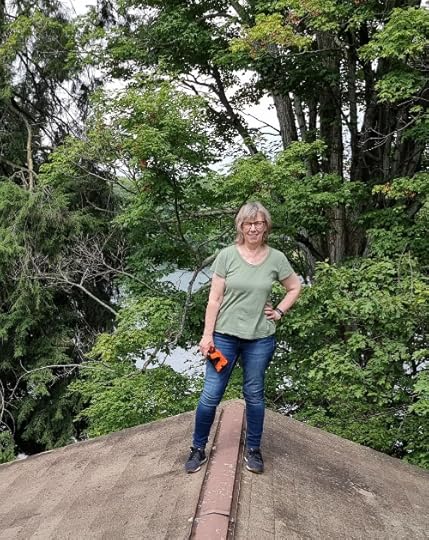 We're back in Montreal after two weeks in central New York working on the lake house. It needs a new roof -- this time I went up there with J. to take a look, after we peered into the attic crawlspace and saw some water damage, which we had suspected -- so we arranged for that to happen next month. The main task was to finish sorting many of my parents' collections and other possessions. At the end of last week an antique dealer's crew and truck arrived, and we all packed and carried what had been designated to leave. At the end of that long day, I was proud of myself for not getting emotional; I was exhausted; and, as much as I had liked many of those things, I was stunned to see how good the house looked and felt in a much simpler and less crowded state.
We're back in Montreal after two weeks in central New York working on the lake house. It needs a new roof -- this time I went up there with J. to take a look, after we peered into the attic crawlspace and saw some water damage, which we had suspected -- so we arranged for that to happen next month. The main task was to finish sorting many of my parents' collections and other possessions. At the end of last week an antique dealer's crew and truck arrived, and we all packed and carried what had been designated to leave. At the end of that long day, I was proud of myself for not getting emotional; I was exhausted; and, as much as I had liked many of those things, I was stunned to see how good the house looked and felt in a much simpler and less crowded state.
If any of you have done this, for yourselves or for your family or friends, you will probably recognize these feelings. For us, it was the third major move/downsizing in 14 months, and we're certainly not done with the work on that house. But as we sat on the front porch that evening, we had a real sense of accomplishment, both for the sheer physical work we'd done, and because, a year ago, I couldn't imagined being able to handle the emotional demands of the task.
I don't know if it's a curse or a blessing, but I am able to remember a lot of my past in detail. Nearly every object in that house and every inch of space is weighted with specific memories of the people who once handled those things, or moved through those rooms, or used the same objects in different houses that I also remember vividly. Because I loved all of those people, and miss them now that they are gone, and because they were all collectors and storytellers who liked history, as well as being makers who restored or created many of the things in the house, there are a lot of complex layers.
Today is the first anniversary of my father's death. Although I dealt with the clothes and personal items shortly after he died, it took a full year for me to get to the point where I could say, all right, it's time for many of these things carefully collected by my parents, grandparents, great aunt and even great-grandparents to move on to new people who will also appreciate them. It finally feels ok for us to change the house and make it more our own, for the time in which we have it, and to do so without guilt. Part of getting there is the process of mourning and letting go, but I think it's also difficult and complicated to accept, and then acknowledge, the fact that we are now the elders: we have taken our parents' place.
My father had a clear conception of what he wanted the house to be when he designed and built it, with my mother's help. It's a real mid-century aesthetic, but for all these years, I don't think that could really be sensed during the several decades it took to finish the house. Later, there were so many interesting things in the house competing for visual attention that you didn't really see the space itself. When the shelves and surfaces were cleared, and some of the furniture removed, we could suddenly see and appreciate the integrity of what my parents had planned. I wondered if maybe they would have liked it too, in some sort of alternate universe. All in all, I'm grateful for the memories I have, and during these recent days I was glad to be able to talk about all them with my cousin next door, and to friends whose relationship with our family goes back three generations.
As I wrote last winter, in a long essay that will be published this year along with my series of winter landscape drawings, the land and nature of central New York are also a consolation for me. The fields that had been covered with snow were now filled with towering rows of bright green, tasseled corn, or with freshly mown hay; the skies were't grey but bright blue with lazy summer clouds; deer grazed all over the countryside, along with turkeys and rabbits and other small mammals; hawks swept over the meadows; rising fish made circles on the water and swallows skimmed over the surface chasing insects; and a noisy flock of Canada geese arrived each evening to sleep on the lake, leaving again after the sun had chased away the wispy morning fog. The rhythm of rural life continued, both on the farms, and independently in nature, and there was comfort in that in spite of the changes in the climate.
During the past four weeks, I haven't touched my sketchbook, haven't read or written much at all, and certainly haven't written here - this may be the longest period I've gone without writing on the blog. Today felt like a time to try to put some of this into words, and I also spent the afternoon doing an oil pastel of Chenango County hills -- the first work in color that has come out of this time.
I'd rather not see this moment as an ending, because so much of what has been remains inside of me. Let's call it a continuation that's also morphing into something new.
July 26, 2023
A Report on my Summer Sewing Binge - Part 2
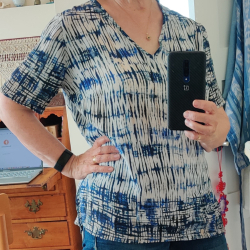
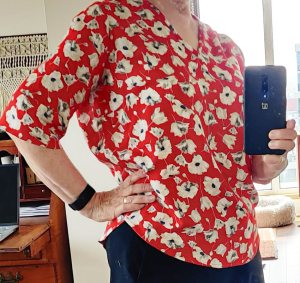
In this post, I'll talk about the costs of the sewing projects, my satisfaction with the results and a critique of their shortcomings, and what I hope to sew in the future.
So, at the end of my current sewing spree, I ended up with six new garments -- three tops, one jumpsuit, one pair of pants, and one dress -- and one previously purchased and now altered top.
The total fabric cost was $130.98 (US$). I also spent $31.69 for the patterns used in these projects. I plan to re-use all of those, plus there are 15 patterns in the Japanese sewing book that I haven’t used at all yet. I spent about $20.00 on sewing notions: thread, buttons, fusible interfacing, and a roll of pattern-tracing paper. So the grand total for the sewing project expenses was $182.67.
If bought in stores, similar garments in equivalent fabrics (pure linen or linen-blends) might cost $65 for each of the tops, $150 for the jumpsuit, $50-100 for the pants, and $180 or more for the dress. That total comes to somewhere around $575 - $625, which I never would have spent.
The orange linen top that I altered (below left) originally cost $49.90 and was unwearable; now it fits properly and I'll wear it a lot.
From the time I was young, sewing my own clothes was the difference between having new, unique, and more plentiful clothes, and making do with older things and buying a few new ones from time to time. This summer, prior to deciding to sew, I considered buying a linen dress ($70 online) and a pair of light-colored linen slacks from Uniqlo ($45) in addition to the skirt and top I ordered from Grae Cove ($54.90 + 49.90). That would have been a total of $219.00 for four pieces, and that would have been it. In the end I spent $182.67 on the sewing projects and 104.80 on the two pieces I ordered, so my total expenditure for eight garments, rather than four, was $287.47.
Quality and Satisfaction
For those of us who like to knit and sew, the time we spend isn't really a factor in the economic equation, because we enjoy doing it and presumably have enough skill or determination to figure we're learning more in the process, that we have the skill and/or patience to persevere until we have a decent result, and therefore our time won't be wasted. Even so, in recent years many former sewers have complained that it isn't worth it to sew for yourself anymore because fabric has gotten so expensive. I beg to disagree. You do have to spend some time online researching fabric sources if you don't live near good stores, but beautiful fabric is available and if you look, you can find it at a good price. For US sewers, sites like FabricDepot are quite an amazing resource. High-end designer fabrics can be found at places like Mood Fabrics, and I've found and purchased many unusual fabrics, including Indian and Asian textiles, from sellers on Etsy.
I'm happy with the garments I made. The purple linen dress is totally unique, feels great to wear, and not only did I learn a lot making it, it's inspiring me to learn more about Japanese design. I've been living in the white linen-cotton pants (above) - a nice, lighter change from my usual jeans. The tops have all been in regular rotation, and they've held up well when I washed them. The crinkly linen-rayon white top (below) needs a good ironing after washing, so i don't think I will take it when I travel, but the white-and-blue tie-die print will be coming along with me for sure, as will the red floral rayon top (both shown at the top of this post) which can be dressy or casual.
Fitting pants is always tricky. If I make another Zadie jumpsuit, which I hope to do, I will probably alter the leg width and crotch seam slightly to decrease the rise and slim the legs a bit -- but wearing the jumpsuit is so totally comfortable as it is -- it feels like pajamas. I also forgot that I am longwaisted when I cut the jumpsuit bodice, and made a note to myself on the pattern to add an inch of length next time around. For the linen pants, I already altered the rise and crotch seam after basting the seams, and would do it even a little more in another iteration; I would also use wider elastic for the back waist and secure it with more rows of horizontal stitching. Using stay tape on the pocket openings made a big difference; I didn't do this on the jumpsuit and don't like how much the pockets gape open. But none of these criticisms of the fit or sewing techniques will keep me from wearing or enjoying the garments.
Future Plans
The gaps in my wardrobe were much bigger for summer clothes than winter ones. However, I'm already thinking ahead. I have a large piece of lightweight grey-striped linen that will become a long blouse, from a pattern in the Japanese sewing book. I also have a great rayon viscose print that will become a dress, but in a simple pattern to show off the print.
If I make another jumpsuit, it will be with sleeves and in a somewhat heavier fabric for colder weather. The most exciting prospect is a vintage Issey Miyake pattern I found on Etsy. I used to own a related pattern of his for a dress, but never made it. This one contains a jacket, shirt, and skirt -- and I like these separates better. I can't wait to make that skirt (see the schematic below), perhaps in a woven Japanese ikat if I can find something suitable, or a lightweight wool.
What About You?
Obviously, I've been sewing a long time. If you haven't, what you see here probably feels daunting, but I want to encourage you. A lot of us learned to sew and did a few projects, only to give up because the fit was wrong, or we lacked the experience to create garments that didn't look handmade (in a embarrassing way!) What I want to say is that you don't have to tackle a complicated project off the bat -- and you shouldn't. But ANYONE can make a simple linen or cotton top, dress, or skirt. If you want to try, my suggestion is to take a course at a local sewing store or community center, or even online, OR find a friend who's willing to help you get started, or re-started. Ask advice on good patterns to begin with, and start with a traditional, purchased paper pattern in an envelope from a company like McCall's, Butterick, Simplicity, or Very Easy Vogue -- they will contain clear instructions, you won't have to add seam allowances or trace anything, and the pattern instructions will help you learn. if you're using a local chain store like JoAnn's or Fabricville, ask for help at the cutting counter to make sure your pattern and fabric are a good match. Buy fabric you really like, but don't begin with something super-expensive, and don't start out with stretchy knits or flimsy or slippery fabrics, no matter how alluring they look in the store. You want dimensionally-stable cloth that isn't going to stretch or slip as you cut it and sew it; learn and hone your skills on that before you move on to more challenging fabrics. Also, ironing is a very important part of sewing, so make sure you have a good iron with adjustable heat settings and steam, and a sturdy ironing board.
I'm a great believer in the satisfaction that comes from making and doing things yourself, and find this an antidote to so much of what feels wrong about our disposable, ever-faster, highly commercial, media-driven culture. It's a great feeling to create something from scratch that is uniquely yours, to use it and enjoy it, and to learn from the project so that you are inspired for the next one. The biggest key to success is to start simply, and find some helpful friends or resource people who can advise you about your choices and your process when you're having difficulties. Nobody is born knowing how to do these things! Just as in cooking, we all have to learn, we all get better at it gradually, and there is always something cool and exciting to aspire to in the future.

